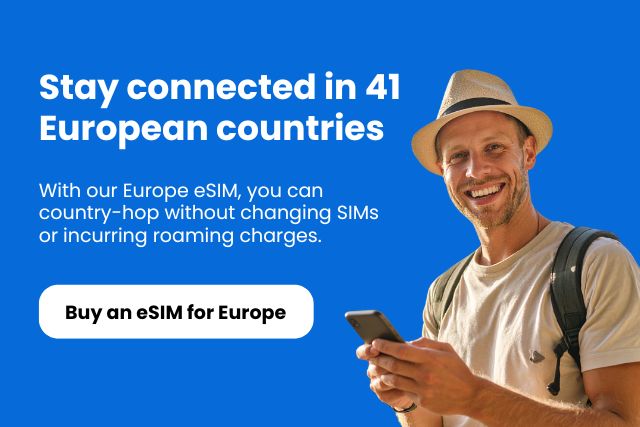5 Secret Hacks to Save Money When Traveling to Europe in 2025

Europe is calling your name, and you’re already booked to answer. Now, let’s make sure you don’t empty your bank account once you land.
You’ve spent countless hours scouring Reddit threads, binging TikTok travel hacks, and reading travel blogs to find the real money-saving tips.
The good news? It’s totally possible to turn that dream Euro adventure into a budget-friendly reality.
Whether you’re after the best Europe itinerary, wondering how to travel Europe cheap, or simply seeking the best budget travel trip in Europe, you’re in the right place.
From walking tours to gelato and free data plans, here are five practical ways to save money while traveling to Europe in 2025.
These aren’t grandpa’s generic travel tips; they’re fresh insights straight from travelers who’ve been there, done that, and saved a ton. Let’s dive in!
1. Avoid Overpaying on Mobile Data (Stay Connected With an eSIM)

Ever been hit with a nasty phone bill after traveling? Yeah, not fun.
Using your country’s phone plan in Europe can quietly rack up fees – international roaming data, expensive international calling rates, etc.
But these days, you have better options.
Some budget travelers actually go off-grid from cell service and rely solely on Wi-Fi; they hop between free Wi-Fi hotspots throughout their European trips and avoid getting any local SIM or plan.
While Wi-Fi hopping can work in a pinch, it can be inconvenient (and let’s be honest, a bit risky if you need to use banking apps or get lost in a city with no offline map).
That’s why when it comes to traveling to Europe in 2025, many savvy planners choose eSIMs.
If you’re not familiar, an eSIM is a digital SIM card you can purchase online and activate on your phone (as long as your phone is eSIM-compatible, which most newer phones are).
It’s super handy – no finding a SIM vendor, no swapping physical SIM cards, and you set it up before you even leave home.
We emphasize not relying on “patchy café Wi-Fi or expensive roaming” when a simple eSIM can keep you connected affordably.
Companies like GigSky offer Europe eSIM plans that cover 41 countries, including Turkey and Cyprus, so you can country-hop without changing SIMs or incurring roaming charges.
With the 100MB free plan, you can try the GigSky eSIM before committing to a full package, no credit card required.
Essentially, you get high-speed data for a set price, and your phone works just like at home: Google Maps, WhatsApp, Instagram – all of it, anywhere on the continent.
And if you’re a Visa Infinite or Visa Signature cardholder from the US, Canada, or Latin America, you get 1–3GB of free data and 20–30% off any additional plan.
So, if you need to stay connected, look into the GigSky eSIM. It’s a simple win for anyone planning a trip to Europe and hoping to stay within budget.
2. Get Money Back With VAT Refunds

Planning a trip to Europe that includes a little shopping? Don’t forget to claim VAT refunds as a non-EU visitor.
Europe includes a VAT (value-added tax) in the price of goods, up to 25% in some places. But you may be eligible for a VAT refund when leaving the EU.
Here’s how it works:
When shopping at a store that offers VAT refunds, ask for the VAT form at checkout. There’s usually a minimum spend.
Bring your passport while shopping, it’s often required.
At the airport, get your form stamped by customs, then process it at a refund kiosk or drop it in a prepaid box.
You can get the refund via credit card, PayPal, or even cash at the airport.
The refund won’t be the full amount (they take a cut), but it’s still 10–15% back in your pocket. Not bad if you’ve splurged on leather goods in Florence or skincare in Paris.
Just make sure to plan extra time at the airport, especially in busy terminals like Charles de Gaulle.
3. Leverage Free and Cheap Activities

Some of Europe’s best experiences are free, or almost free – perfect if you’re exploring Europe on a budget.
Start with free walking tours, available in most cities. These are usually tip-based tours led by passionate local guides.
There are great ones in Amsterdam and Paris; people usually tip €10–15, and it’s still cheaper than any paid option. Some cities even offer themed tours, like Bucharest’s donation-based history walk or Berlin’s street art tours.
Many museums have free entry days or discounts. Paris offers free museum Sundays once a month, and Rome’s Colosseum has no-cost days (but expect crowds). Students and youth should always carry ID; discounts are common.
When you’re traveling to Europe in 2025, some of the best moments come from simply enjoying public spaces. Whether it’s strolling through a park, people-watching in a plaza, or visiting a cathedral, your Europe itinerary doesn’t have to break the bank.
Even an entire afternoon sipping a €3 cappuccino in a sunny square feels priceless.
Tourist passes like the Paris Museum Pass or London Pass offer serious savings if you plan to visit multiple attractions.
But always do the math. Sometimes individual tickets or local combo deals (like in Kraków’s Wawel Castle) are cheaper. A bit of research on Europe trip advice blogs can help you find the best-value options.
4. Mind Your Money (Cards & Currency)

Avoid unnecessary fees by getting smart about how you pay.
Use a credit card with no foreign transaction fees to save 2–3% on every purchase.
For cash, skip currency exchanges, and withdraw from ATMs using a debit card that refunds fees. Charles Schwab’s debit card is a favorite among U.S. travelers because it reimburses global ATM fees.
One more crucial tip: when you do pay by card in Europe, sometimes the card reader will ask if you want to be charged in the local currency or your home currency (USD).
Always choose the local currency. It might feel reassuring to see the charge in dollars, but what’s happening behind the scenes is dynamic currency conversion – basically, a third party is doing the conversion at a lousy rate and maybe adding a commission.
There’s no benefit to you paying in USD abroad. You’re better off letting your bank handle the conversion at the standard rate.
5. Eat Like a Local (and at Local Times)

Food is one of the greatest joys when traveling to Europe in 2025, and you can eat amazingly well without blowing your budget.
Avoid tourist traps on the main streets. Instead, eat where locals eat: markets, street food stalls, and neighborhood cafes. You’ll get better food for half the price.
Make lunch your main meal. Many restaurants offer “menu of the day” specials at noon. In Spain, you might get a starter, main, dessert, and drink for €12.
At dinner, the same meal could cost €20 or twice as much. Italy’s pasta lunches are dreamy, and far more affordable than dinner.
In the evening, try picnic dinners. Grab fresh bread, cheese, olives, and a €5 bottle of wine from a grocery store or market.
Then head to a park or waterfront spot for one of the most budget-friendly (and romantic) meals you’ll ever have.
If your lodging has a kitchen, cook once in a while. Supermarkets in Europe are fun to explore, and you can whip up delicious local dishes for a few euros.
Don’t forget the little savings: carry a reusable water bottle (tap water is safe almost everywhere, and Italy has public fountains!). Keep snacks in your bag to avoid impulse buys like €7 hot dogs.
Even coffee has hacks. In Italy, you’ll pay €1 to stand at the bar… or €3 to sit down. Locals know. Follow their lead.
BONUS: Use Public Transport (and Transit Tricks)

Public transportation in Europe is excellent, and cheap.
Avoid taxis and ride public transit instead. Cities offer day or week passes for metro and buses.
Berlin’s daily U-Bahn pass is great. London’s Oyster card caps your fare after a few rides.
Eastern Europe? Local taxis are cheap, think $3 rides across town in Sofia, Bulgaria.
But the cheapest way to get around? Walk. Europe’s cities are made for it. Wandering through old towns is basically a free sightseeing tour.
For long-distance travel, buses and night trains beat pricey flights or high-speed rail. FlixBus has dirt-cheap routes, starting from 19 €. And an overnight ride can double as your accommodation, saving you a night’s stay.
You can also try ride-sharing apps like BlaBlaCar. You chip in for gas and join a local on their drive between cities.
It’s a great way to travel on the cheap, and make a new friend – ideal for anyone doing Europe on a budget.
To Recap…

Install a GigSky eSIM to avoid roaming fees and stay connected on a budget across Europe.
Get VAT refunds on purchases by following a simple process at the airport.
Enjoy free walking tours, museum deals, and public spaces for budget-friendly travel experiences.
Save on fees by using no-foreign-transaction credit cards and always paying in local currency.
Eat where locals eat, take advantage of lunch deals, and enjoy picnic dinners.
Use public transportation, walk, or try buses and ride-sharing to travel cheaply.
Being smart with your budget doesn’t mean you miss out.
Some of your best travel memories will come from things that cost next to nothing – sharing picnic wine in a park, laughing with a free tour guide, and finding a perfect €1 espresso.
Traveling smart just means your money goes further. You’ll be able to say yes to spontaneous gelatos or day trips without panicking every time you check your balance.
You might even return home bragging about how little you spent on a trip your friends thought would cost thousands.
So get out there. Eat well, walk far, save smart, and enjoy every moment.
Subscribe to Our Blog
%20(1)%201%20(1).png)








